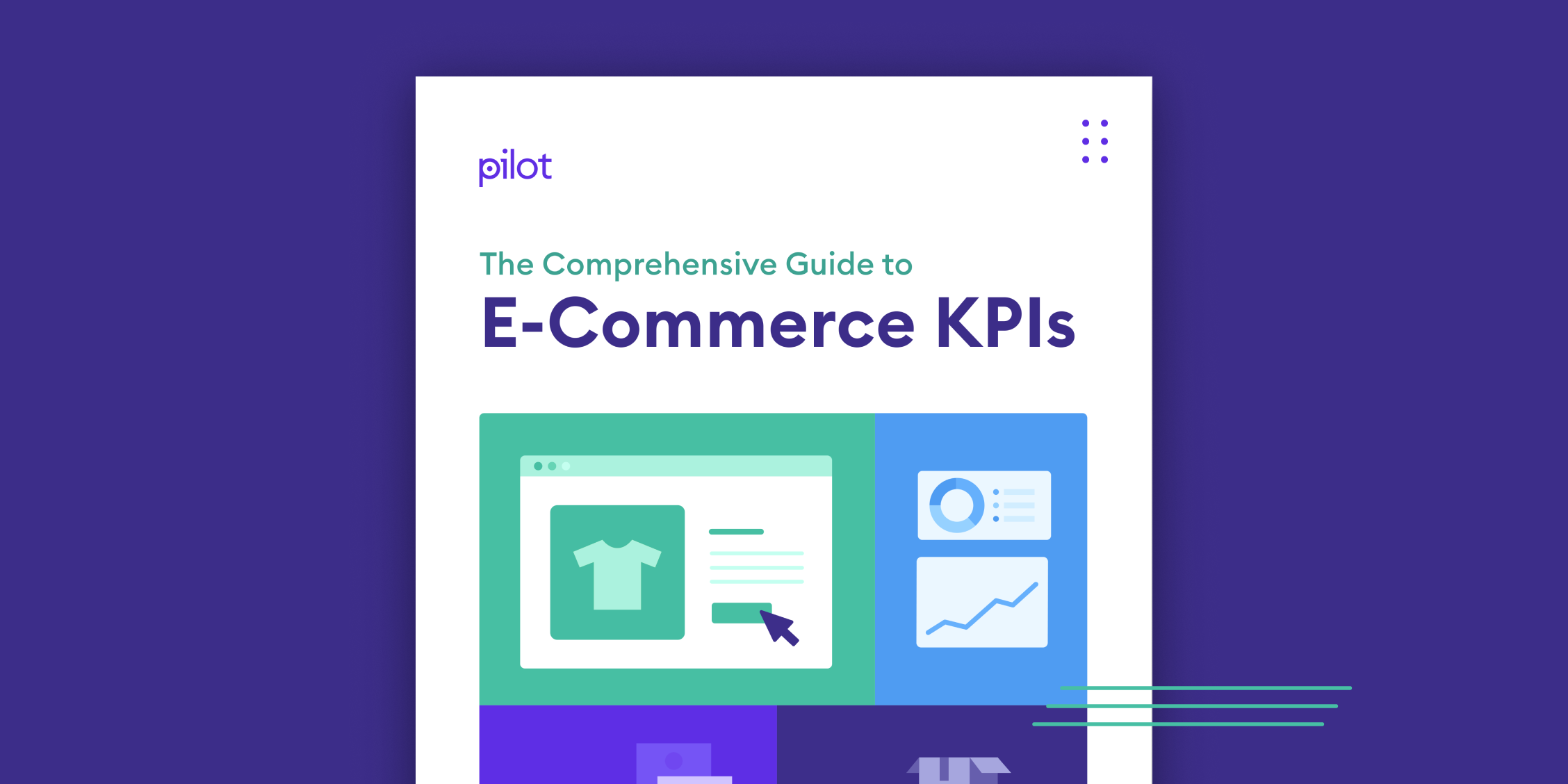6 E-Commerce KPI Metrics Your Need to Monitor
A confirmation email has been sent to your email.

Getting products in front of anyone with access to the internet is an exciting prospect.
Whether you’re keeping up with the times, launching your very first business, or doing a combination of both, e-commerce opens the door to a wide range of opportunities and possibilities.
Apart from controlling how your business is presented to customers and how they can interact with it, website-hosting platforms and online tools offer data-driven insights that enable you to make decisions quickly.
In fact, data collected through your online store allows you to analyze buying trends, identify issues, develop profitable business strategies, and troubleshoot those that are underperforming.
But knowing what KPI data points to focus on, how often they should be checked, and what each one is telling you can get confusing. We’ll explain why you should allocate time and resources into analyzing the data that’s collected from people who visit your online store, as well as some important data points that you should be monitoring regularly.
What are e-commerce KPIs?
E-commerce KPIs, or key performance indicators, are measurable and quantifiable outcomes that are used to determine whether a business is meeting key objectives or goals. These outcomes, expressed as numerical values, are known as metrics.
These figures are derived from organized sets of data that document specific actions over a certain period of time. This information can then be leveraged to assess a company’s short-term performance and guide long-term business strategies.
Online retailers, for instance, tend to closely monitor abandonment rates, which track how often customers place items in their virtual shopping carts but don’t complete the checkout process.
On the whole, e-commerce KPIs focus on customer satisfaction, business growth, pricing sensitivities, and the overall success of your digital marketing efforts as a key driver of online traffic.
Why are e-commerce KPIs important?
On a broader scale, certain KPIs can indicate how well a company’s finances are faring and shaping up. While KPIs aren’t always definitive signs of success or trouble, they can link outcomes to a specific source and let you know where you should focus your attention.
For instance, a high cart abandonment rate doesn’t necessarily point to a serious problem with your business as a whole, especially since the Baymard Institute found that the average across all industries is around 69.8 percent. High cart abandonment rates can hint at issues with your website or checkout process, but you should analyze more specific metrics, such as the actions that customers took after visiting a certain web page, to identify the source of a problem.
To that end, KPIs can offer granular-level insights on how well certain initiatives — and individual teams — are performing.
As an example, conversion and bounce rates for specific web pages, along with the amount of time that customers spent on them, can indicate whether your content in each one is appealing, relevant, informative, and attractive. These website engagement KPIs can also ensure that you have a frictionless browsing and checkout experience in place for customers.
Since multiple teams within your organization are tasked with keeping your online store up and running, it’s important for everyone to be on top of KPIs that directly impact their work.
Digital marketers, for one, need to monitor customer engagement, website conversion, email marketing, and certain finance KPIs to determine whether their efforts are paying dividends. Meanwhile, your sales team should be monitoring customer engagement, customer satisfaction, and finance KPIs to assess their performance
Investors may even ask you about specific KPIs, such as your customer acquisition costs, net profit margin, and average order value to gauge the success of your business.
KPIs also have the power — and potential — to influence key decisions within your organization, especially if specific metrics are either troubling or promising.
For example, a significant drop in your net profit margin and average order value from one period of time to the next will likely warrant further investigation and timely discussions about how to turn the tide. If you wait weeks or months to take action, there’s a decent chance that your organization as a whole is relying on outdated data to make game-changing decisions.
With that being said, your organization as a whole should be checking KPIs consistently and making data-driven decisions quickly. You should also create a schedule for tracking and analyzing KPIs so comparisons from one period to the next are consistent.
How often you check specific KPIs generally depends on the data set that’s used to calculate a metric, how all of that data is collected, and whether there’s enough information available to make informed decisions.
For example, metrics that track online traffic to your website can be checked daily, weekly, or monthly to troubleshoot issues, monitor the performance of specific initiatives, and develop a better idea of how trends change during certain parts of the year.
More specifically, website visits, page views, and number of leads can be viewed on a daily basis since website analytics tools update those numbers regularly. Other website metrics, such as those for specific marketing campaigns and search engine rankings, can be checked once a week and once a month, respectively, since they all require some time to create an accurate picture.
Critical KPIs you should monitor
The KPIs you should track will depend on your overall business goals and the achievements that should be accomplished at specific points in time.
Since e-commerce platforms, such as Shopify and BigCommerce, and website analytics platforms, such as Google Analytics, Adobe Analytics, or HubSpot, can offer a wealth of data to track a wide variety of KPIs, it’s important to focus on those that are most closely aligned with your business goals and will make the most impact.
Let’s say one of your long-term goals is to boost the amount of organic traffic to your website by 20 percent over the next year. With this in mind, you’ll probably want to monitor KPIs that track customer engagement, your website’s rankings on search engines, and where people found you, including rankings for specific keywords, bounce rates, and referring domains.
While the KPIs you track are tied to a number of factors, such as your goals, business model, industry, and growth stage, here are a few key metrics that every e-commerce business should be monitoring:
Net sales
Net sales represent the amount of money that you have left from selling products or goods after returns, discounts, and allowances are taken out of your gross revenue.
Your net sales calculations can also be used to report the total amount of revenue that your company brought in during a certain amount of time on an income statement, also known as a profit and loss statement.
It can be temptingly convenient to view gross sales as a reflection of your company’s financial health and performance, but this metric doesn’t account for any deductions or losses that you may incur. Net sales, on the other hand, is a more accurate gauge of how much is actually generated from selling products or goods online.
Sales dilution rate
Sales dilution is the difference between your gross and net sales. For instance, if your business brought in $975,000 from sales and had a net amount of $829,000 once returns, discounts, and allowances were taken out, the sales dilution rate would be $146,000. When expressed as a percentage of your gross sales, the sales dilution rate would be 17.6 percent.
This metric is important to monitor since it can help you identify issues or inefficiencies and address them quickly before they become increasingly costly problems later on down the line. For example, an unusually high amount of customer returns can suggest that there’s something wrong with specific products, goods, or merchandise. It can also suggest that certain items just weren’t resonating with customers or otherwise meeting their expectations. Though returns can happen for a wide range of different reasons, calculating your net sales can at least help you understand where potential revenue was lost and flag the issue for further investigation.
Contribution Margin
Though it’s not reflected in financial statements, your contribution margin enables you to determine whether marketing and, in some cases, selling costs are eating up too much of your gross profit.
Calculating your contribution margin is particularly helpful if you set aside a decent amount of money to market your products, goods, or services online. Once your contribution margin has been calculated, all other operational costs and your COGS, or cost of goods sold, can be removed to determine your net profit.
Though it’s important to zero in on brand awareness and ensure that visitors to your online store have a relatively frictionless, efficient, and pleasant experience, these efforts can work against you if the costs for it are rising faster than your gross profits. Monitoring your contribution margin can ensure that these discretionary expenses are kept in check.
Basket size
As its name suggests, basket size represents the average number of items that customers bought every time they placed an online order during a specific period of time.
Along with knowing the average number of items that were in each online order, minding your basket size can help you determine why the average amount that customers spent on each order went up or down during a certain time period.
By consistently tracking your average order value and basket size, you can seamlessly analyze the relationship between the amount of money generated from sales and the size of online orders placed during the same time period.
Customer Lifetime Value (CLTV or CLV)
Customer lifetime value, commonly known as CLTV or CLV, is the estimated amount that someone will likely spend during their entire time as a customer of your business. This particular KPI can also help you figure out how many customers must be acquired before your business can be profitable.
Since CLTV is a measure of profit rather than revenue, your calculations should incorporate customer margins into the equation. If you use CLTV to create revenue projections, your calculations won’t consider any of the costs to retain and support customers over time.
To get a better idea of how much profit you’ll actually make, you must take your customer acquisition cost or cost of goods sold into account as well.
Leverage your customer retention cost
Customer retention cost, or CRC, is the total amount that your business spent to ensure that customers will keep buying your products or using your services.
Since it’s often less expensive to retain new customers rather than attract new ones, your customer retention cost will allow you to determine how much is being spent to connect with existing buyers and foster brand loyalty.
While the cost to acquire a customer is as recorded as a one-time expense for each person, your customer retention costs will be recurring for as long as someone wants to keep buying your products, goods, or services.
You can leverage your CRC to determine whether the costs to retain customers are exceeding the amount that they’re spending on your products, goods, or services over time.
Want to take a deeper dive into e-commerce KPIs and learn more about other important metrics that can help you make informed decisions? Check out our comprehensive e-book on e-commerce KPIs and why they matter for your business. If you need someone to crunch the numbers for you or offer insights that are unique to your business, our CFO services team is here to help.
Download the e-commerce KPIs e-book here


